ubuntu 16.04 LAMP 安装
2017-05-06 13:35
295 查看
How To Install LAMP Stack On Ubuntu 16.04
By M.el KhamlichiShare on Facebook
Tweet on Twitter
tweet

LAMP is a combination of operating system and open-source software stack. The acronym LAMP came from the first letters ofLinux, Apache HTTP Server, MySQL or MariaDB database, and PHP/Perl/Python.
This tutorial describes how to install LAMP stack on Ubuntu 16.04,
however the steps described below should work on previous Ubuntu
versions such as Ubuntu 15.10/15.04/14.10/14.04/13.10 etc.
Install LAMP Stack On Ubuntu 16.04
1. Install Apache
Apache is anopen-source multi-platform web server. It provides a full range of web
server features including CGI, SSL and virtual domains.
To install Apache, enter:
sudo apt-get install apache2Enable and start your apache
root@ubuntu:~# systemctl enable apache2 root@ubuntu:~# systemctl start apache2 root@ubuntu:~# systemctl status apache2 ● apache2.service - LSB: Apache2 web server Loaded: loaded (/etc/init.d/apache2; bad; vendor preset: enabled) Active: active (running) since Wed 2016-03-02 09:23:37 PST; 1min 2s ago Docs: man:systemd-sysv-generator(8) CGroup: /system.slice/apache2.service ├─22328 /usr/sbin/apache2 -k start ├─22331 /usr/sbin/apache2 -k start └─22332 /usr/sbin/apache2 -k start Mar 02 09:23:36 ubuntu systemd[1]: Starting LSB: Apache2 web server... Mar 02 09:23:36 ubuntu apache2[22304]: * Starting web server apache2 Mar 02 09:23:36 ubuntu apache2[22304]: AH00558: apache2: Could not reliably determine the server's fully qualified domain name, using 127.0.1.1. Set the 'S Mar 02 09:23:37 ubuntu apache2[22304]: * Mar 02 09:23:37 ubuntu systemd[1]: Started LSB: Apache2 web server. Mar 02 09:24:34 ubuntu systemd[1]: Started LSB: Apache2 web server.Test Apache:Open your web browser and navigate to http://localhost/ or http://server-ip-address/.

2. Install MySQL
MySQL is a relationaldatabase management system (RDBMS) that runs as a server providing
multi-user access to a number of databases, though SQLite probably has
more total embedded deployments
sudo apt-get install mysql-server mysql-clientDuring installation, you’ll be asked to setup the MySQL “root” user password. Enter the password and click Ok.

Re-enter the password.
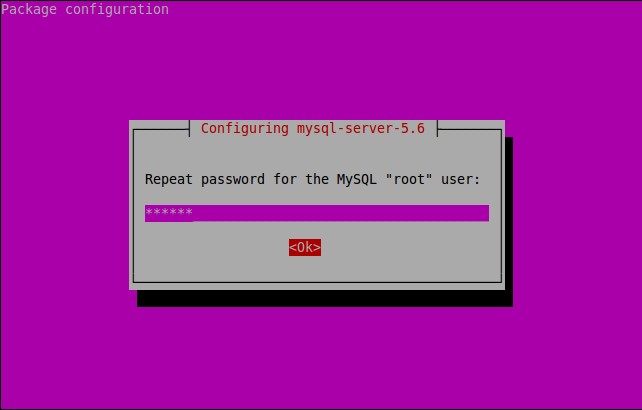
MySQL is installed now.You can verify the MySQL server status using command:On Ubuntu 16.04/15.10/15.04:
sudo systemctl status mysqlOn Ubuntu 14.10 and previous versions:
sudo service mysql statusSample output:
● mysql.service - MySQL Community Server Loaded: loaded (/lib/systemd/system/mysql.service; enabled; vendor preset: enabled) Active: active (running) since Mon 2015-10-26 14:23:01 IST; 28s ago Main PID: 3577 (mysqld_safe) CGroup: /system.slice/mysql.service ├─3577 /bin/sh /usr/bin/mysqld_safe └─3924 /usr/sbin/mysqld --basedir=/usr --datadir=/var/lib/mysql --... Oct 26 14:23:00 server systemd[1]: Starting MySQL Community Server... Oct 26 14:23:00 server mysqld_safe[3577]: 151026 14:23:00 mysqld_safe Can't .... Oct 26 14:23:00 server mysqld_safe[3577]: 151026 14:23:00 mysqld_safe Loggin.... Oct 26 14:23:01 server mysqld_safe[3577]: 151026 14:23:01 mysqld_safe Starti...l Oct 26 14:23:01 server systemd[1]: Started MySQL Community Server. Hint: Some lines were ellipsized, use -l to show in full.
3. Install MariaDB
In case you want to use MariaDB instead of MySQL community edition, follow the steps given below.MariaDB is a drop in replacement for MySQL. It is a robust, scalable and reliable SQL server that comes rich set of enhancements.First you have to remove existing MySQLpackages if any. To completely uninstall MySQL along with its
configuration files, enter the following commands one by one:
sudo systemctl stop mysql
sudo apt-get remove --purge mysql-server mysql-client mysql-common
sudo apt-get autoremove
sudo apt-get autoclean
sudo rm -rf /var/lib/mysql/
sudo rm -rf /etc/mysql/After removing MySQL, run the following command to install MariaDB.
sudo apt-get install mariadb-serverAlternatively, you can install it using MariaDB repository
if you want to try most recent version of MariaDB. Run the following
commands to add PPA. As of writing this, MariaDB PPA is not yet updated
to Ubuntu 16.04. However, we can use the repository of Ubuntu 15.10
instead.
sudo apt-get install software-properties-common
sudo apt-key adv --recv-keys --keyserver hkp://keyserver.ubuntu.com:80 0xcbcb082a1bb943db
sudo add-apt-repository 'deb http://download.nus.edu.sg/mirror/mariadb/repo/10.1/ubuntu vivid main'Update the software sources list and install MariaDB using following commands:
sudo apt-get update
sudo apt-get install mariadb-serverDuring installation you will be asked to
set mysql ‘root’ user password. Enter the password twice, and complete
the installation.Important Note: In Ubuntu 16.04/15.10/15.04, MariaDB won’t ask you to set root user password during installation.Also, you can’t set password manually using the following command too:
mysql_secure_installationIt will throw the following error.
NOTE: RUNNING ALL PARTS OF THIS SCRIPT IS RECOMMENDED FOR ALL MariaDB SERVERS IN PRODUCTION USE! PLEASE READ EACH STEP CAREFULLY! In order to log into MariaDB to secure it, we'll need the current password for the root user. If you've just installed MariaDB, and you haven't set the root password yet, the password will be blank, so you should just press enter here. Enter current password for root (enter for none): ERROR 1698 (28000): Access denied for user 'root'@'localhost'Enter current password for root (enter for none):To fix this error, log in to mysql prompt without password as root user:
sudo mysql -u rootThen, run the following commands one by one in the mysql prompt:
use mysql;
update user set plugin='' where User='root';
flush privileges;
\qThat’s it. Now, set database administrative “root” user password using command. Press Enter and go with the default settings.
mysql_secure_installationSample output:
NOTE: RUNNING ALL PARTS OF THIS SCRIPT IS RECOMMENDED FOR ALL MariaDB SERVERS IN PRODUCTION USE! PLEASE READ EACH STEP CAREFULLY! In order to log into MariaDB to secure it, we'll need the current password for the root user. If you've just installed MariaDB, and you haven't set the root password yet, the password will be blank, so you should just press enter here. Enter current password for root (enter for none): OK, successfully used password, moving on... Setting the root password ensures that nobody can log into the MariaDB root user without the proper authorisation. Set root password? [Y/n] y New password: Re-enter new password: Password updated successfully! Reloading privilege tables.. ... Success! By default, a MariaDB installation has an anonymous user, allowing anyone to log into MariaDB without having to have a user account created for them. This is intended only for testing, and to make the installation go a bit smoother. You should remove them before moving into a production environment. Remove anonymous users? [Y/n] ... Success! Normally, root should only be allowed to connect from 'localhost'. This ensures that someone cannot guess at the root password from the network. Disallow root login remotely? [Y/n] ... Success! By default, MariaDB comes with a database named 'test' that anyone can access. This is also intended only for testing, and should be removed before moving into a production environment. Remove test database and access to it? [Y/n] - Dropping test database... ERROR 1008 (HY000) at line 1: Can't drop database 'test'; database doesn't exist ... Failed! Not critical, keep moving... - Removing privileges on test database... ... Success! Reloading the privilege tables will ensure that all changes made so far will take effect immediately. Reload privilege tables now? [Y/n] ... Success! Cleaning up... All done! If you've completed all of the above steps, your MariaDB installation should now be secure. Thanks for using MariaDB!Check if mariadb is running or not, using the following command:
sudo service mysql statusSample output:
● mysql.service - LSB: Start and stop the mysql database server daemon Loaded: loaded (/etc/init.d/mysql) Active: active (running) since Mon 2015-10-26 14:26:36 IST; 2min 5s ago Docs: man:systemd-sysv-generator(8) CGroup: /system.slice/mysql.service ├─6387 /bin/bash /usr/bin/mysqld_safe ├─6388 logger -p daemon err -t /etc/init.d/mysql -i └─6544 /usr/sbin/mysqld --basedir=/usr --datadir=/var/lib/mysql --... Oct 26 14:26:39 server /etc/mysql/debian-start[6595]: mysql.time_zone_transit... Oct 26 14:26:39 server /etc/mysql/debian-start[6595]: mysql.time_zone_transit... Oct 26 14:26:39 server /etc/mysql/debian-start[6595]: mysql.user ... Oct 26 14:26:39 server /etc/mysql/debian-start[6595]: Phase 2/6: Fixing views Oct 26 14:26:39 server /etc/mysql/debian-start[6595]: Processing databases Oct 26 14:26:39 server /etc/mysql/debian-start[6595]: information_schema Oct 26 14:26:39 server /etc/mysql/debian-start[6595]: mysql Oct 26 14:26:39 server /etc/mysql/debian-start[6595]: performance_schema Oct 26 14:26:39 server /etc/mysql/debian-start[6653]: Checking for insecure r... Oct 26 14:26:39 server /etc/mysql/debian-start[6657]: Triggering myisam-recov... Hint: Some lines were ellipsized, use -l to show in full.
4. Install PHP (PHP7)
PHP (recursive acronymfor PHP: Hypertext Preprocessor) is a widely used open-source general
purpose scripting language that is especially suited for web development
and can be embedded into HTML.Install PHP with following command:
sudo apt-get update sudo apt-get install php7.0-mysql php7.0-curl php7.0-json php7.0-cgi php7.0 libapache2-mod-php7Test your php version
root@ubuntu:~# php -v PHP 7.0.3-3 (cli) ( NTS ) Copyright (c) 1997-2016 The PHP Group Zend Engine v3.0.0, Copyright (c) 1998-2016 Zend Technologies with Zend OPcache v7.0.6-dev, Copyright (c) 1999-2016, by Zend Technologies root@ubuntu:~#To test PHP, create a sample “testphp.php” file in Apache document root folder.
sudo vi /var/www/html/testphp.phpAdd the following lines:
<?php phpinfo(); ?>Restart apache2 service.On Ubuntu 15.10/15.04:
sudo systemctl restart apache2On Ubuntu 14.10 and lower versions:
sudo service apache2 restartNavigate to http://server-ip-address/testphp.php. It will display all the details about php such as version, build date and commands etc.
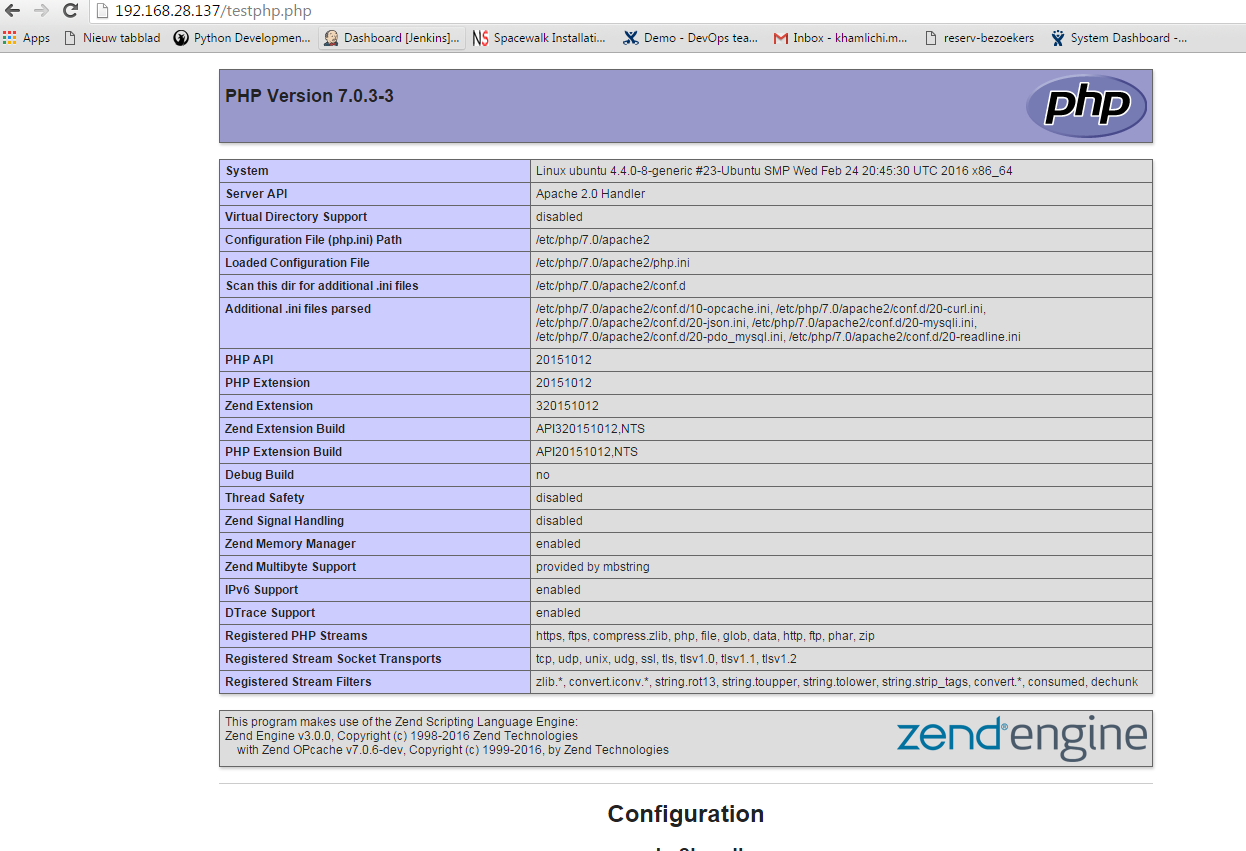
If you want to install all php modules at once, enter the command sudo apt-get install php* and restart the apache2 service. To verify the modules, open web browser and navigate to http://server-ip-address/testphp.php. You will able to see all installed php modules.
5. Manage MySQL Databases (Optional)
Install phpMyAdminphpMyAdmin is a freeopen-source web interface tool used to manage your MySQL databases. It
is available in the Official Debian repositories. So install it with
command:
sudo apt-get install phpmyadminSelect the Web server that should be automatically configured to run phpMyAdmin. In my case, it is apache2.

The phpMyAdmin must have a database
installed and configured before it can be used. This can be optionally
handled by dbconfig-common.Select ‘Yes’ to configure database for phpmyadmin wjth dbconfig-common.

Enter password of the database’s administrative user.
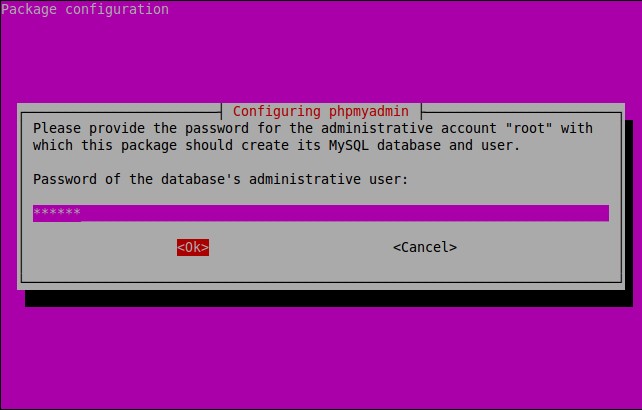
Enter MySQL application password for phpmyadmin:
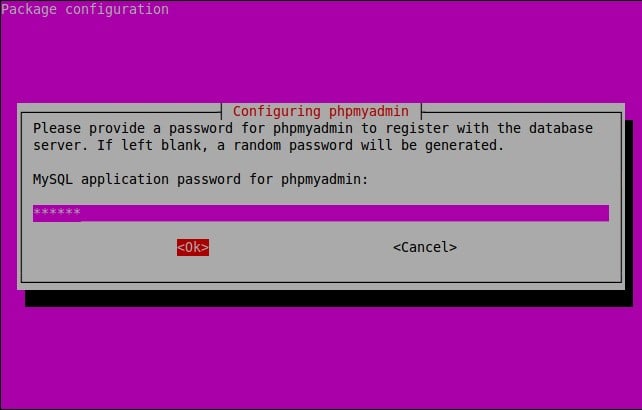
Re-enter password:
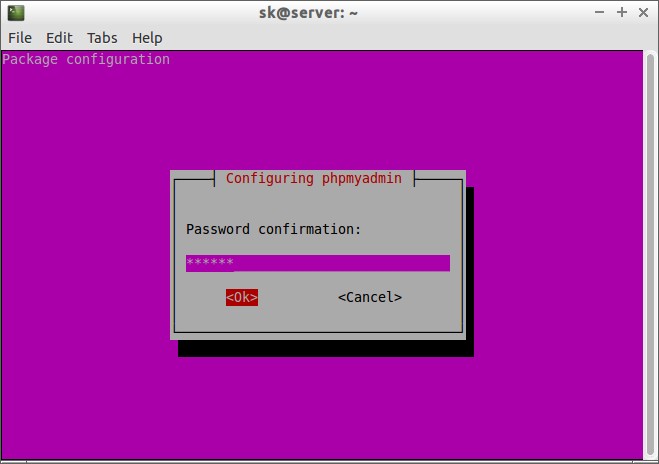
Success! phpMyAdmin installation is installed.Additional Note: if you
followed all steps carefully, phpMyAdmin should work just fine. In case
phpMyAdmin is not working, please do the following steps.Open terminal, and type:
sudo nano /etc/apache2/apache2.confAdd the following line at the end.
Include /etc/phpmyadmin/apache.confSave and Exit. Restart apache service:On Ubuntu 16.04/15.10/15.04:
sudo systemctl restart apache2On Ubuntu 14.10 and lower versions:
sudo /etc/init.d/apache2 restart
6. Access phpMyAdmin Web Console
Now, you can access the phpmyadmin console by navigating to http://server-ip-address/phpmyadmin/ from your browser.Enter your MySQL username and password which you have given in previous steps. In my case its “root” and “ubuntu”.
You will be redirected to PhpMyAdmin main web interface.

From here, you can manage your MySQL databases from phpMyAdmin web interface.That’s it. Your LAMP stack is ready to use.
相关文章推荐
- 图解 Ubuntu Server 16.04 LTS 上安装 LAMP
- ubuntu 16.04 安装LAMP
- ubuntu 16.04安装lamp
- VM虚拟机上安装Ubuntu16.04的phplamp环境
- Ubuntu16.04 配置安装 LAMP Apache2+MySQL+PHP
- ubuntu16.04安装lamp和swoole
- 在 Ubuntu Server 16.04 LTS 上安装 LAMP
- Ubuntu 16.04 安装 LAMP 及各种扩展
- ubuntu16.04 LAMP安装
- ubuntu16.04 安装lamp环境备忘
- Ubuntu 16.04 下安装 LAMP
- 在 Ubuntu Server 16.04 LTS 上安装 LAMP
- Ubuntu Server 16.04 LTS 上安装 LAMP图解教程
- 在 Ubuntu Server 16.04 LTS 上安装 LAMP
- Ubuntu16.04安装LAMP环境
- Ubuntu 16.04 安装LAMP经典架构
- Ubuntu下LAMP安装
- [转]ubuntu下 手动安装 LAMP 和 JAVA环境
- 安装ubuntuserver和lamp遇到的问题,google解决的答案
- ubuntu LAMP 解决验证码不能显示问题 安装gd2库
